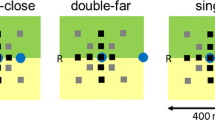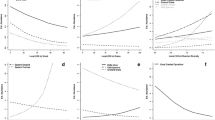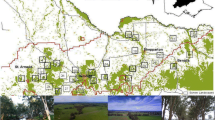Abstract
Despite increasing revegetation of cleared landscapes around the world, there is limited research on the implications of different types of plantings for birdlife. We examined the “intersection effect”, whereby species richness is higher at the intersection of “corridors” or vegetation strips for birds inhabiting replanted areas. We also examined individual species responses. Replicated sites at the intersections of plantings were compared with “internal controls” (located in the same plantings ∼100 m from intersections), “external controls”(sites in isolated linear plantings), and block plantings. We surveyed the 39 sites in our experimental design repeatedly – on different days by different observers and in different seasons. We found no significant difference in species richness between intersections and block plantings, but intersections had higher species richness than isolated linear strips and the internal controls. Similar results were found for bird assemblage scores derived by correspondence analysis. We found evidence of extra-variation at the farm-level for species richness and derived assemblage scores, suggesting a farm-scale response. This suggests the importance of other (often unmeasured) factors at the farm level (e.g. baiting for feral animals). Our results suggest that replanting programs aimed at maximizing bird species richness may benefit from consideration of planting geometry. In particular, linking strip plantings to create intersections and/or establishing block plantings appear to be superior to isolated strips for aggregate species richness.

Similar content being viewed by others
References
Barrett G (2000) Birds on farms: ecological management for agricultural sustainability. Supplement to Wingspan: Volume 10 (4). Birds Australia, Victoria, Australia
Baudry J (1984) Effects of landscape structure on biological communities: the case of hedgerow network landscapes. In: Brandt J, Agger P (eds) Proceedings of the first international seminar on methodology in landscape ecological research and planning. Roskilde Universitetsforlag GeoRuc, Roskilde, Denmark
Bennett AF (1998) Linkages in the landscape: the role of corridors and connectivity in wildlife conservation. IUCN, Gland, Switzerland
Bennett AF, Kimber S, Ryan P (2000) Revegetation and wildlife. A guide to enhancing revegetated habitats for wildlife conservation in rural environments. Bushcare Research Report 2/00. Bushcare National Research and Development Program Research Report, Canberra, Australia
Benson J (1999) Setting the scene—the native vegetation of New South Wales. Native Vegetation Advisory Council. Royal Botanic Gardens, Sydney, Australia
Bond SJ (2004) Do woodland birds breed in revegetated sites? Honours Thesis. The Australian National University, Canberra
Brooker L (2002) The application of focal species knowledge to landscape design in agricultural lands. Landsc Urban Plan 60:185–210
Cooper CB, Walters JR, Ford H (2002) Effects of remnant size and connectivity on the response of Brown Treecreepers to habitat fragmentation. Emu 102:249–256
Cunningham RB, Lindenmayer DB, Nix HA, Lindenmayer BD (1999) Quantifying observer heterogeneity in bird counts. Aust J Ecol 24:270–277
Cunningham RB, Lindenmayer DB, Crane M, Michael D, MacGregor C (2007) Large scale revegetation and mammal and reptile response: novel multi-scale and interactive effects. Ecol Appl 17:609–619
Er K, Tidemann CR (1996) Importance of Yellow Box-Blakely’s Red Gum woodland remnants in maintaining bird species diversity: inferences from seasonal data. Corella 20:117–125
Field SA, Tyre AJ, Possingham HP (2002) Estimating bird species richness: how should repeat surveys be organized in time? Austral Ecol 27:624–629
Fischer J Lindenmayer DB (2002) The conservation value of paddock trees for birds in a variegated landscape in southern New South Wales. I. Species composition and site occupancy patterns. Biodivers Conserv 11:807–832
Forman RF (1995) Landscape mosaics. Cambridge University Press, Cambridge, United Kingdom
Freudenberger D (2001) Bush for the birds: biodiversity enhancement guidelines for the Saltshaker Project, Boorowa, NSW. CSIRO and Greening Australia, ACT and SE NSW Inc
Freudenberger D, Harvey J (2004) Predicting biodiversity benefits of the Saltshaker Project, Boorowa, NSW. Ecol Manage Restor 5:5–14
Fry GL (1989) Conservation in agricultural ecosystems. In: Spellerberg IF, Goldsmith FB, Morris MG (eds) The scientific management of temperate communities for conservation. Blackwell Scientific, Oxford
Galwey NW (2006) Introduction to mixed modelling: beyond regression and analysis of variance. John Wiley, London
Gibbons P, Boak M (2002) The value of paddock trees for regional conservation in an agricultural landscape. Ecol Manage Restor 3:205–210
Greenacre MJ (1984) Theory and applications of correspondence analysis. Academic Press, London
Greening Australia (2001) Bringing birds back: a glovebox guide for bird identification and habitat restoration in ACT and SE NSW. Greening Australia ACT and SE NSW, Australia
Hobbs RJ, Yates CJ (2000) Temperate eucalypt woodlands in Australia. Surrey Beatty and Sons, Chipping Norton, Australia
Kavanagh R, Law B, Lemckert F, Stanton M, Chidle M, Brassil T, Towerton A, Herring M (2005) Biodiversity in eucalypt plantings established to reduce salinity. Rural Industries Research and Development Corporation Report 05/165. November 2005, Canberra, Australia
Keast A (1968) Seasonal movements in the Australian honeyeaters (Meliphagidae) and their ecological significance. Emu 67:159–210
Kinross C (2004) Avian use of farm habitats, including windbreaks, on the New South Wales tablelands. Pac Conserv Biol 10:180–192
Koenig WD (1998) Spatial autocorrelation in California land birds. Conserv Biol 12:612–620
Lack PC (1988) Hedge intersections and breeding bird distribution in farmland. Bird Study 35:133–136
Lambeck RJ (1999) Landscape planning for biodiversity conservation in agricultural regions. A case study from the wheatbelt of Western Australia. Biodiversity Technical Paper No. 2. pp 1–96. Environment Australia, Canberra, Australia
Levey DJ, Bolker BM, Tewksbury JJ, Sargent S, Haddad NM (2005) Effects of landscape corridors on seed dispersal by birds. Science 309:146–148
Lindenmayer DB, Beaton E, Crane M, Michael D, MacGregor C, Cunningham R (2005) Woodlands: a disappearing landscape. CSIRO Publishing, Melbourne
Lindenmayer DB, Fischer J (2006) Habitat fragmentation and landscape change: an ecological and conservation synthesis. Island Press, Washington, DC
Lindenmayer DB, Fischer J (2007) Tackling the habitat fragmentation panchreston. Trends Ecol Evol 22:127–132
Martin WK, Eyears-Chaddock M, Wilson BR, Lemon J (2004) The value of habitat reconstruction to birds at Gunnedah, New South Wales. Emu 104:177–189
Némethová D, Tirinda A (2005) The influence of intersections and dead-ends of line-corridors networks on the breeding bird distribution. Folia Zool 54:123–134
Noss RF (1987) Corridors in real landscapes: a reply to Simberloff and Cox. Conserv Biol 1:159–164
Noss RF, Beier P (2000) Arguing over little things: response to Haddad et al. Conserv Biol 15:1546–1548
Pyke GH, Recher HF (1983) Censusing Australian birds: a summary of procedures and a scheme for the standardization of data presentation and storage. In: Davies SJ (ed) Methods of censusing birds in Australia. Proceedings of a symposium organised by the Zoology section of the ANZAAS and the Western Australian Group of the Royal Australasian Ornithologists Union. Department of Conservation and Environment, Perth, Australia, pp 55–63
Riffell SK, Gutziller KJ (1996) Plant-species richness in corridor intersections: is intersection shape influential? Landsc Ecol 11:157–168
Robinson D (1992) Habitat use and foraging behaviour of the Scarlet Robin and the Flame Robin at a site of breeding season sympatry. Wildlife Res 19:377–395
Rosenberg DK, Noon BR, Meslow EC (1997) Biological corridors: form, function and efficacy. BioScience 47:677–687
Ryan PA (2000) The use of revegetated areas by vertebrate fauna in Australia: a review. In: Hobbs RJ, Yates C (eds) Temperate eucalypt woodlands in Australia: biology, conservation, management and restoration. Surrey Beatty and Sons, Chipping Norton, Australia, pp 318–335
Salt D, Lindenmayer DB, Hobbs RJ (2004) Trees and biodiversity. a guide for Australian farm forestry. Joint Venture Agroforestry Program. Rural Industries Research and Development Corporation, Canberra
Schall R (1991) Estimation in generalized linear models with random effects. Biometrika 78:719–727
Seddon, J, Briggs S, Doyle S (2001) Birds in woodland of the central wheat/sheep belt of New South Wales. NSW National Parks and Wildlife Service, Canberra. February 2001
Simberloff D, Farr JA, Cox J, Mehlman DW (1992) Movement corridors: conservation bargains or poor investments? Conserv Biol 6:493–504
Smith PA (1994) Autocorrelation in logistic regression modeling of species’ distribution. Global Ecol Biogeogr 4:47–61
Stirzaker R, Vertessy R, Sarre A (eds) (2002) Trees, water and salt: an Australian guide to using trees for healthy catchment and productive farms. Joint Venture Agroforestry Program, Canberra, Australia
Acknowledgments
This work was supported by Natural Heritage Trust, Land and Water Australia and Australian Research Council grants to The Australian National University. Dr. J. Fischer and Dr. A. Manning kindly assisted with several aspects of the study and made useful critical comments on earlier versions of the manuscript. We most gratefully acknowledge the private landholders who allowed access to their properties.
Author information
Authors and Affiliations
Corresponding author
Rights and permissions
About this article
Cite this article
Lindenmayer, D.B., Cunningham, R., Crane, M. et al. Farmland bird responses to intersecting replanted areas. Landscape Ecol 22, 1555–1562 (2007). https://doi.org/10.1007/s10980-007-9156-9
Received:
Accepted:
Published:
Issue Date:
DOI: https://doi.org/10.1007/s10980-007-9156-9




